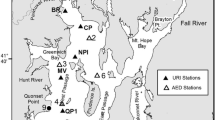Abstract
Multifactor regression analysis was used to test for relationships between chemical, physical and optical properties of the water column in the organically rich, highly turbid waters of Florida's Fort Pierce Inlet. Optical measurements were made at three visible light wavelengths (445 nm, 542 nm and 630 nm). Scattering by suspended particulate material was found to be the primary optical mechanism controlling downwelling irradiance at all three wavelengths. Larger particles showed constant scattering efficiencies of 2 when their diameters exceeded 3 to 5 microns, depending upon the wavelength used for observation. Selective absorption had a definite effect on the transmission of radiant energy in the 445 nm wavelength range. High correlation between extinction at 445 nm and the cross-sectional area of the suspended particulate material indicates particulate, rather than dissolved materials, are the major water column constituents that selectively absorb short wavelength radiant energy in this inlet. Spectral distribution of the downwelling radiant energy field was found to shift dramatically over a period of several months. These shifts in downwelling spectral irradiance were attributed to seasonal and/or event related shifts in concentrations of selectively absorbing compounds within the water column.
Similar content being viewed by others
Literature Cited
Burt, W. V. 1955. Distribution of suspended materials in Chesapeake Bay.J. Marine Res. 14:47–62.
Burton, J. D., and P. S. Liss. 1976. Estuarine chemistry. Academic Press.
Hodkinson, J. R. 1963. Light scattering and extinction by irregular particles larger than the wavelength, p. 87–100.In M. Kerker (ed.). Electromagnetic Scattering. Macmillan.
Jerlov, N. G. 1968. Optical oceanography. Elsevier Publishing Co.
Klemas, V., andD. F. Polis. 1977. Remote sensing of estuarine fronts and their effects on pollutants.Photogrammetric Engineering. 43:599–612.
Kullenberg, G. 1974. Observed and computed scattering functions, p. 25–49.In N. G. Jerlov and E. S. Nielson (eds.) Optical aspects of oceanography. Academic Press.
Lawson, R. A. 1977. The application of remote sensing techniques to determine the spectral radiance reflectance in the Fort Pierce Inlet area. M. S. Thesis, Florida Institute of Technology, Melbourne, Florida.
Lawson, R. A., M. J. Thompson, and W. R. McCluney. 1977. Determination of upwelling spectral radiance in Fort Pierce Inlet, Florida. Proc. Fall Tech. Meeting, Am. Soc. Photogram. 204–216.
Lorenzen, C. J. 1972. Extinction of light in the ocean by phytoplankton.J. Cons. int. Explor. Mer. 34:262–267.
Maynard, V. I., L. A. Barnard, andR. R. Jolley. 1975. Water quality measurements in the Anclote River Estuary during 1974, p. 177–198.In G. F. Mayer and V. I. Maynard (eds.). Anclote Environmental Project Report 1974. University of South Florida, St. Petersburg, Florida.
McCluney, W. R. 1975. Remote measurement of “Turbidity” and other water quality parameters. NASA/Goddard Space Flight Center.
Morel, A., andL. Prieur. 1977. Analysis of variations in ocean color.Limnol. Oceanogr. 22:709–722.
Owen, R. W. 1974. Optically effective area of particle ensembles in the sea.Limnol. Oceanogr. 5:584–590.
Petzold, T. J. 1972. Volume scattering functions for selected ocean waters. SIO Ref. 72-78. Visibility Laboratory, San Diego, California.
Strickland, J. D. H., and T. R. Parsons. 1972. A practical handbook of seawater analysis. 2nd ed. Bull. Fish. Res. Bd. Canada p. 167.
Taras, M. J., A. E. Greenberg, R. D. Hoak, and M. C. Rand. 1971. Standard methods for the examinations of water and wastewater, 13th ed. American Public Health Association.
Tyler, J. E. 1961. Scattering properties of distilled and natural waters.Limnol. Oceanogr. 6:451–456.
Author information
Authors and Affiliations
Rights and permissions
About this article
Cite this article
Thompson, M.J., Rosenfeld, L.K. Light scattering and extinction in a highly turbid coastal inlet. Estuaries 2, 164–171 (1979). https://doi.org/10.2307/1351730
Issue Date:
DOI: https://doi.org/10.2307/1351730



